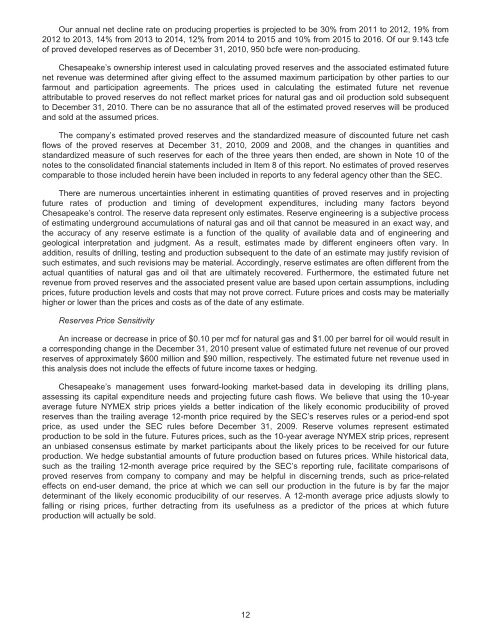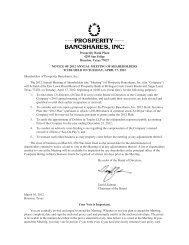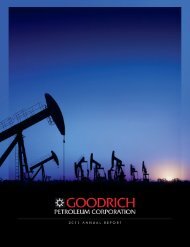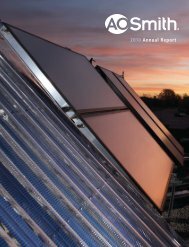6 5 - RR DONNELLEY FINANCIAL - External Home Login
6 5 - RR DONNELLEY FINANCIAL - External Home Login
6 5 - RR DONNELLEY FINANCIAL - External Home Login
Create successful ePaper yourself
Turn your PDF publications into a flip-book with our unique Google optimized e-Paper software.
Our annual net decline rate on producing properties is projected to be 30% from 2011 to 2012, 19% from<br />
2012 to 2013, 14% from 2013 to 2014, 12% from 2014 to 2015 and 10% from 2015 to 2016. Of our 9.143 tcfe<br />
of proved developed reserves as of December 31, 2010, 950 bcfe were non-producing.<br />
Chesapeake’s ownership interest used in calculating proved reserves and the associated estimated future<br />
net revenue was determined after giving effect to the assumed maximum participation by other parties to our<br />
farmout and participation agreements. The prices used in calculating the estimated future net revenue<br />
attributable to proved reserves do not reflect market prices for natural gas and oil production sold subsequent<br />
to December 31, 2010. There can be no assurance that all of the estimated proved reserves will be produced<br />
and sold at the assumed prices.<br />
The company’s estimated proved reserves and the standardized measure of discounted future net cash<br />
flows of the proved reserves at December 31, 2010, 2009 and 2008, and the changes in quantities and<br />
standardized measure of such reserves for each of the three years then ended, are shown in Note 10 of the<br />
notes to the consolidated financial statements included in Item 8 of this report. No estimates of proved reserves<br />
comparable to those included herein have been included in reports to any federal agency other than the SEC.<br />
There are numerous uncertainties inherent in estimating quantities of proved reserves and in projecting<br />
future rates of production and timing of development expenditures, including many factors beyond<br />
Chesapeake’s control. The reserve data represent only estimates. Reserve engineering is a subjective process<br />
of estimating underground accumulations of natural gas and oil that cannot be measured in an exact way, and<br />
the accuracy of any reserve estimate is a function of the quality of available data and of engineering and<br />
geological interpretation and judgment. As a result, estimates made by different engineers often vary. In<br />
addition, results of drilling, testing and production subsequent to the date of an estimate may justify revision of<br />
such estimates, and such revisions may be material. Accordingly, reserve estimates are often different from the<br />
actual quantities of natural gas and oil that are ultimately recovered. Furthermore, the estimated future net<br />
revenue from proved reserves and the associated present value are based upon certain assumptions, including<br />
prices, future production levels and costs that may not prove correct. Future prices and costs may be materially<br />
higher or lower than the prices and costs as of the date of any estimate.<br />
Reserves Price Sensitivity<br />
An increase or decrease in price of $0.10 per mcf for natural gas and $1.00 per barrel for oil would result in<br />
a corresponding change in the December 31, 2010 present value of estimated future net revenue of our proved<br />
reserves of approximately $600 million and $90 million, respectively. The estimated future net revenue used in<br />
this analysis does not include the effects of future income taxes or hedging.<br />
Chesapeake’s management uses forward-looking market-based data in developing its drilling plans,<br />
assessing its capital expenditure needs and projecting future cash flows. We believe that using the 10-year<br />
average future NYMEX strip prices yields a better indication of the likely economic producibility of proved<br />
reserves than the trailing average 12-month price required by the SEC’s reserves rules or a period-end spot<br />
price, as used under the SEC rules before December 31, 2009. Reserve volumes represent estimated<br />
production to be sold in the future. Futures prices, such as the 10-year average NYMEX strip prices, represent<br />
an unbiased consensus estimate by market participants about the likely prices to be received for our future<br />
production. We hedge substantial amounts of future production based on futures prices. While historical data,<br />
such as the trailing 12-month average price required by the SEC’s reporting rule, facilitate comparisons of<br />
proved reserves from company to company and may be helpful in discerning trends, such as price-related<br />
effects on end-user demand, the price at which we can sell our production in the future is by far the major<br />
determinant of the likely economic producibility of our reserves. A 12-month average price adjusts slowly to<br />
falling or rising prices, further detracting from its usefulness as a predictor of the prices at which future<br />
production will actually be sold.<br />
12











